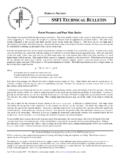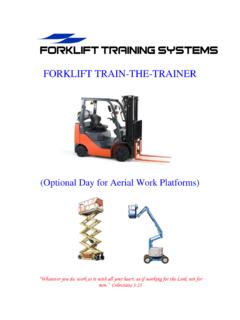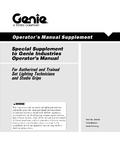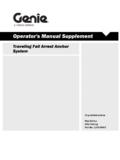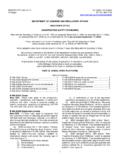Transcription of Rescue Plans for Aerial Work Platform Use - SAIA
1 Page 1 of 2 of Rescue Plans for Aerial Work Platform Use Rescue Plans for Aerial Work Platform Use Why are Rescue Plans Important when Operating Aerial Work Platforms (AWPs)? Workers restrained by a full-body harness and lanyard can experience suspension trauma following a fall from an Aerial Work Platform (AWP) when they are suspended for a period of time. Lack of muscle movement in the legs can cause pooling of blood in the lower body and the worker may pass out. Age, fitness, dehydration and harness fit all play a role in the duration of time before the onset of suspension trauma. Death can occur if a person is left suspended for too long. It is important to have a plan in place to quickly Rescue a worker suspended after experiencing a fall. Typical Contents of a Rescue plan o Company and Work Site Name o Address of Work Site Location o Fall Hazards - Assessment and identification of all existing and potential fall hazards at work site o Procedures - Detailed procedures used for the implementation, assembly, inspection, use, maintenance and dismantling of fall protection equipment and any equipment involved in the Rescue of a worker o Fall Protection Systems Description of all fall protection systems used to protect workers from fall hazards ( travel restraint, personal fall arrest system, safety net, control zone, etc), including those used for Rescue of a worker.
2 Where present, identification of the anchors, both engineered and improvised, that workers are to use o Clearance Distances Assessment, confirmation and documentation of clearance distances Options for Rescue o Ground Controls Rescue Plans should include steps to ensure that other personnel have been trained and familiarized to operate the machine from the ground controls and that a key is left in the ground controls during operation. o Second AWP Make sure your Rescue Plans include the availability of a second AWP along with operators trained to use it in the event an operator becomes incapacitated along with a method to transfer personnel in a way that prevents falling. o Portable Lift Certain situations will allow for a portable lift to be used as part of a Rescue plan to aid in the Rescue of incapacitated workers at height by providing the portability of a ladder but the benefit of an Aerial work Platform . Be sure personnel assigned to the lift in the Rescue plan have been trained and familiarized.
3 O Pre-installed Self- Rescue System These systems are after-market add-on s that can be installed in the basket or Platform of an Aerial work Platform that will allow the operator to self- Rescue by leaving the basket and using a secondary means to safely lower themselves to another safe level. These systems require extensive training and machine manufacturer approval prior to installation. o Self Rescue Equipment Much like pre-installed self- Rescue systems, self- Rescue equipment provides an Aerial work Platform operator a tool or device to allow them to lower themselves from the machine in the event of an emergency. This equipment requires extensive training and machine manufacturer approval prior to use. Page 2 of 2 of Rescue Plans for Aerial Work Platform Use Through the OSHA and Scaffold & Access Industry Association (SAIA) Alliance, SAIA developed this Tip Sheet for informational purposes only. It does not necessarily reflect the official views of OSHA or the Department of Labor.
4 August 2013. Steps to Follow When a Worker is Suspended o If self- Rescue is impossible, or if Rescue cannot be performed promptly, the worker should be trained to pump his/her legs frequently to activate the muscles and reduce the risk of venous pooling. Footholds can be used to alleviate pressure, delay symptoms, and provide support for muscle pumping. o Continuously monitor the suspended worker for signs and symptoms of orthostatic intolerance (caused by venous pooling of blood) and suspension trauma. o Ensure that a worker receives standard trauma resuscitation once rescued. Some authorities recommend that the patient be transported with the upper body raised. o If the worker is unconscious, keep the worker s air passages open and obtain first aid. o Monitor the worker after Rescue , and ensure that the worker is evaluated by a healthcare professional. The worker should be hospitalized when appropriate. Possible delayed effects, such as kidney failure, which is not unusual in these cases, are difficult to assess on the scene.
5

